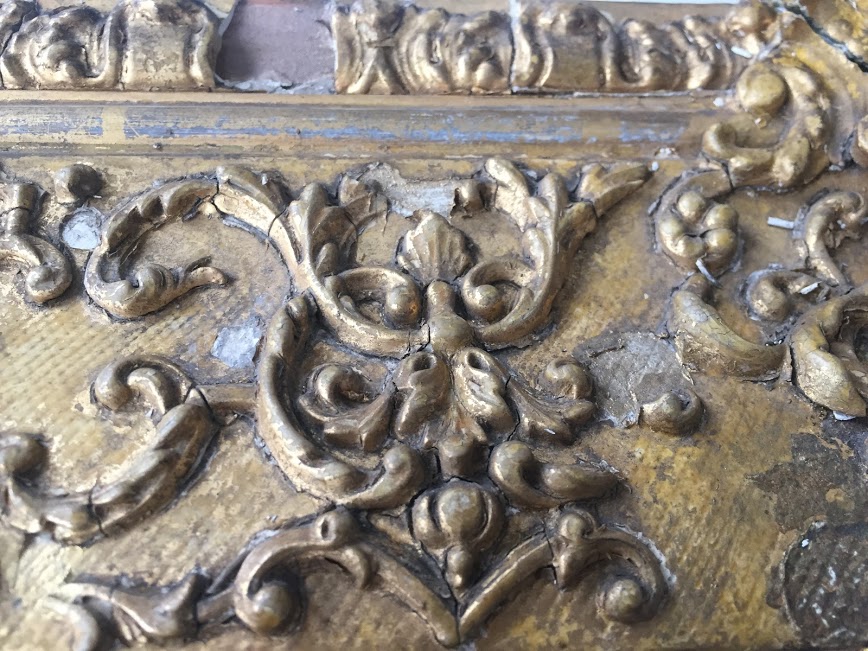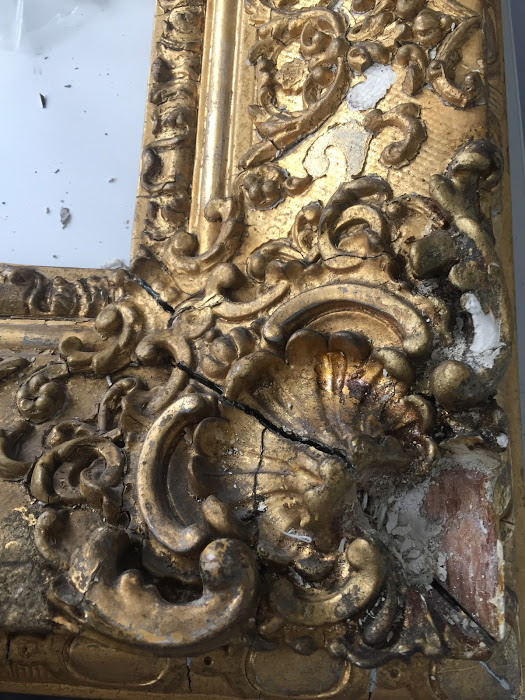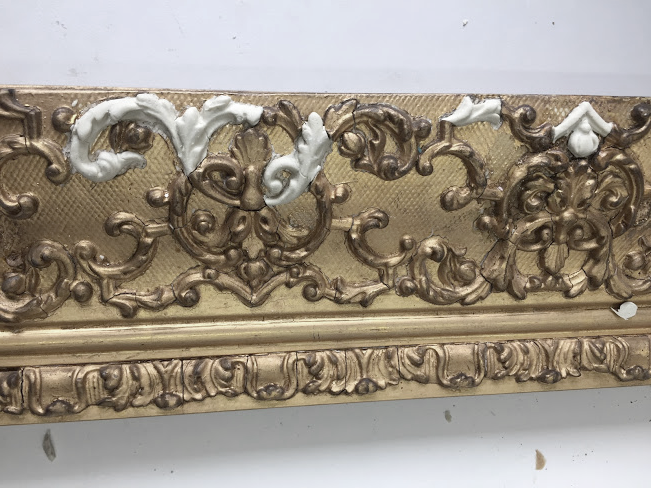This treatment was carried out whilst I was completing a month long internship in the paintings department at Artlab in Adelaide. Under the supervision of the team, particularly Frame Conservator Lisette Burgess, I gained some fantastic experience and inspiring insights into the techniques involved in frame conservation. The frame treated was a highly ornamented composition (compo) frame and included a combination of water and oil gilding.


Cleaning
The frame had an overall layer of surface dirt, particularly accumulated on the bottom edge as result of hanging. It was decided that due to the overall nature of the dirt, which was embedded amongst the interstices of the decoration, that a partial cleaning was appropriate. This would maintain an overall aged surface patina and importantly protect the gilding from excessive mechanical cleaning action. Once deciding on an acceptable cleaning level, cleaning was undertaken using a swab dampened with deionised water. Care was taken not to touch areas of water gilding, which are water soluble, or to mechanically over clean the oil gilding or gesso layer beneath the leaf.
Areas of previous restoration which detracted from the aesthetic cohesion of the frame were also removed. The use of methylated spirits was effective in removing drip stains along the edges of the frame, which due to the dark orange tinting and spirit solubility, was believed to be shellac (Rivers & Umney 2003, p. 179). It was particularly important to monitor the adjacent areas upon cleaning, as I soon learnt how sensitive to removal the gilding could be. Some residual staining had to be accepted out of care not to damage original materials by over cleaning.
Acetone was used to remove areas of overpaint which appeared dark and obtrusive. This was sometimes used synergistically and in alternation with a 2% (w/v) triammonium citrate solution. The use of triammonium citrate is evaluated further in Morrison et al (2007).
Consolidation
Due to the overall instability of the frame ornament, consolidation was necessitated prior to, during and after cleaning. Using rabbit skin glue and a fine bristled brush, loose decorative elements were consolidated and re-adhered to the frame.
Infilling

Areas of topographical loss not related to raised surface ornament were filled with gesso to create a levelled, fine and uniform surface in preparation for gilding (Rivers & Umney 2003, p. 684). The gesso was heated to a workable consistency, applied using a brush and allowed to dry before applying another layer. This gradual building is important to compensate for the shrinkage upon drying of the previous layer (Fuster-López 2012, p. 599), and to ensure good adhesion between layers. The fill was built just above the height of the frame and then carefully sanded back to achieve a smooth and level surface. It was also necessary to rough up the surface of the fill using a scalpel to match the aesthetic qualities of the original frame.
Areas of loss in the decorative elements required a more methodical treatment. Using a polysiloxane dental putty Lisette made the appropriate moulds required for the casting by firmly pressing the material against the design. The detail of the decoration required a material that had sufficiently flexible working properties but could still create a sharp imprint. Once the moulds had set, the next step was to make the compo that would be used for casting. The compo was made by heating rosin, linseed oil, whiting and hide glue and mixing it in thoroughly by hand in a well of whiting. Once reaching the correct pigment volume concentration (PVC) the material showed good strength, flexibility, easy handling properties as well as dimensional and mechanical compatibility with the compo frame (Fuster-López 2012, p. 605). The material was put in the fridge for storage until casting, and excess compo was frozen for later use.
Casting was a patient task. The compo was removed from the fridge, wrapped in a damp cloth to prevent dehydration and heated in the microwave for 6-10 seconds to create a workable material. It was necessary to continue heating the filler as we worked to maintain this consistency. Once pressed into the mould, a rolling pin was employed to create a depth that when applied to the frame, ensured the compo would sit level with the original decoration. Alternatively, the composition was cut to the correct depth with a thin long blade (a Sculpey knife). The compo was removed from the mould when slightly hardened, cut using a scalpel to fill the areas of loss in the design and attached using rabbit skin glue. Once dried, gaps were infilled using compo, and surfaces smoothed using water. I assisted in ornament replacement along the side members of the frame where the pattern and level was consistent, albeit alternating in orientation. The corners, however, were more complex due to more dramatic losses, previous restorations and the various angles and positions of the ornament. Put it down to student novelty, but the detail and accuracy of the work that the conservators executed during the infilling stage was particularly impressive.
Gilding
Using the most intact corner as a guide, a grey bole was applied to infills that replaced original water gilded elements. The application of the bole was gradual, in layers upon layers. The thickness of the gesso and bole layers provided a compressible cushion that enabled the eventual burnishing of the gold leaf with an agate stone to a high sheen, consistent with the original design. All other infills were toned to match the underlying aged composition, creating a cohesive sealed background for the addition of gold leaf.
I feel lucky to have been able to practice gilding under such direct guidance, however much more practice is needed! Two layers of leaf were applied to the water gilded areas and one layer to the oil gilded areas (using a 3 hour oil applied over new compo only). I soon learnt that it was important to develop a sense for the correct level of tack of the drying oil, as the correct tackiness determines the window of working time for applying the gold leaf and the resultant smoothness and appearance of the gold. The excess gold was brushed off when the materials had completely dried, and the areas of water gilding were burnished using an agate stone after an interval of a few hours.
Toning

The final day of my internship saw very satisfying work in being able to apply my developing skills in toning to the frame. The shine of the gold leaf applied to the infills created a stark contrast between the dirt patina of the original frame. We toned down the gilding to achieve aesthetic cohesion in colour, texture and sheen. Unfortunately, my internship finished just prior to the completion of the project, but I am told that some final finishing was undertaken. This included light distressing of the burnished water gilding with ‘0000’ steel wool to reflect surrounding patterns of wear, which has unfortunately not been captured in the provided images.

What I had hoped to achieve in completing the internship was a greater sense of which area of conservation specialisation I would like to pursue. I did not expect to have any experience with frames, but the experience I did gain opened up another door of interest that combined structure with finesse. I only wish I had taken more effective photos to capture the beautiful result of the treatment.
I truly enjoyed my time learning from the paintings department at Artlab, and am thoroughly appreciative for all the time, effort and genuine enthusiasm that the whole staff put forward in giving me an array of practical experiences that I will continue to develop.
Grace Barrand, University of Melbourne
References
Fuster-López, L 2012, ‘Filling’ in J H Stoner and R Rushfield (eds.), The Conservation of Easel Paintings, Routledge Taylor & Francis Group, New York.
Morrison, R, Bagley-Young, A, Burnstock, A, van den Berg, K J and van Keulen, H 2007, ‘An Investigation of Parameters for the Use of Citrate Solutions for Surface Cleaning Unvarnished Paintings’, Studies in Conservation, vol. 52, no. 4, pp. 255-270.
Rivers, S and Umney, N 2003, Conservation of Furniture, Butterworth-Heinemann, Oxford.